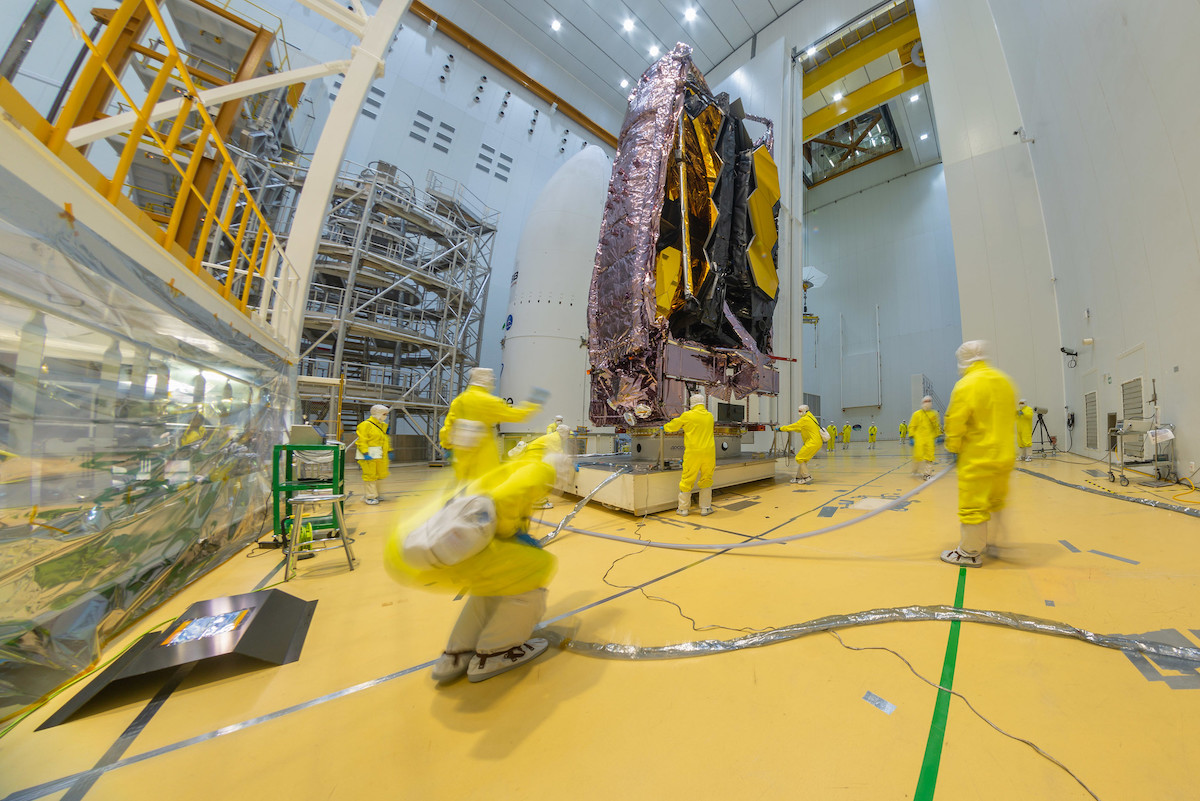EDITOR’S NOTE: Updated at 5:30 p.m. EST (2230 GMT) with update on when NASA will release a new target launch date for Webb.

Technicians at a jungle spaceport in South America are completing tests on the James Webb Space Telescope Thursday to make sure they fixed a “finicky” communications interface glitch that halted launch preparations earlier this week.
NASA and European Space Agency officials will confirm the mission’s target launch date — currently penciled in for no earlier than Dec. 24 — as soon as Friday.
Officials said Thursday morning they didn’t want to officially announce a new target launch date until teams in French Guiana finished an “aliveness” test of the Webb telescope, already mounted on top of its Ariane 5 rocket inside a hangar.
“We’re not taking any risks with Webb,” said Thomas Zurbuchen, head of NASA’s science mission directorate. “It’s already risky enough the way it is. We’re absolutely making sure everything works.”
Webb cost NASA, ESA and the Canadian Space Agency around $9.7 billion to design and develop since the 1990s. The once-in-a-generation mission will the most expensive scientific instrument ever shot into space.
Crews at the Guiana Space Center in Kourou, French Guiana, hoisted the Webb telescope on top of its European Ariane 5 launcher Saturday, Dec. 11. But teams discovered intermittent data dropouts in a communications interface between the observatory and the launch system.
A data cable routes signals from the telescope down the length of the rocket and through the Ariane 5 launch platform. The connection is a piece of ground support equipment, meaning it’s only used on the ground before liftoff.
Zurbuchen said NASA engineers are leading the effort to troubleshoot the problem, with assistance from ESA and Arianespace, the rocket’s launch service provider.
“We believe they have found (the communications interface issue), but the proof is in the pudding,” Zurbuchen said Tuesday. “The thing needs to go through the aliveness test successfully before we say (we can proceed).”
These things happen in the launch business, Zurbuchen said. “It’s just when it’s Webb, there are no small problems.”
Managers planned to meet at 6 p.m. EST (2300 GMT) Thursday to discuss whether to go forward with the launch campaign. Officials announced earlier this week that the launch of Webb would be delayed from Dec. 22 to no earlier than next Friday, Dec. 24, to allow time for the unplanned troubleshooting.
The launch was previously delayed from Dec. 18 after a clamp band connecting Webb with its payload adapter inadvertently opened during processing inside a clean room at the French Guiana spaceport. Managers ordered extra tests to make sure the observatory wasn’t damaged from vibrations induced during the incident, and Webb came back with a clean bill of health.
Zurbuchen said he was “pretty optimistic’ about Webb being cleared for the rest of the launch campaign.
“But don’t take that to the bank yet,” he said. “We need to get through that test.”
If the testing Thursday finished on schedule, ground crews could encapsulate Webb inside the Ariane 5 rocket’s Swiss-made payload fairing Friday. A crane will lower the nose shroud over the observatory on top of the Ariane 5 launcher, completing assembly of the rocket that will send Webb toward its operating post in orbit around the L2 Lagrange point, a gravitationally-stable location four times farther than the moon.
“Nothing is routine about Webb, but it’s a lot more routine after that because the spacecraft is now encapsulated, and it’s mostly rocket stuff,” Zurbuchen said. “And with the tremendous track record that ESA and Arianespace have, a launch date can be established.”
“When a spacecraft is on top of the rocket, you want to get it off the planet as soon as possible, after you do all the checks,” Zurbuchen said.
NASA said earlier Thursday that officials would release an update on Webb’s launch date Thursday night. Zurbuchen tweeted later in the day that an update on the schedule won’t come until Friday.
Webb is the largest space telescope in history, 100 times as powerful as the 30-year-old Hubble Space Telescope. It’s folded up to fit inside the 17.7-foot (5.4-meter) diameter of the Ariane 5 rocket’s nose cone, the widest fairing of any currently operational launch vehicle.
Once in space, the observatory will deploy a solar panel, unfurl high-gain communications antenna, and then open a five-layer thermal to block heat and light from the sun from reaching the telescope’s mirrors and infrared detectors. Then Webb will open two wings to finish setting up the telescope’s primary mirror, which spans more than 21 feet (6.5 meters) in diameter.
The primary mirror is made up of 18 individual hexagonal segments. Each mirror segment is made of beryllium and coated in a thin layer of gold to aid reflectivity. Working in unison, the 18 mirrors will focus light on a secondary mirror, and then into the observatory’s instrument module, which houses detectors chilled as cold as minus 447 degrees Fahrenheit, just 7 degrees above absolute zero.
Webb will seek out light from the first galaxies after the Big Bang nearly 13.7 billion years ago. The observatory’s instruments will also study the atmospheres of planets around other stars, revealing which ones might be habitable.
“Are we alone? Is Earth unique? Do we have other planets out there that can host life?” said Antonella Nota, ESA’s project scientist for Webb, in a press conference Thursday. “Very ambitions questions that speak to all of us. So Webb will study in detail the atmospheres of these exoplanets and we are looking for elements like methane, oxygen, water — the building blocks for life.”
Email the author.
Follow Stephen Clark on Twitter: @StephenClark1.
